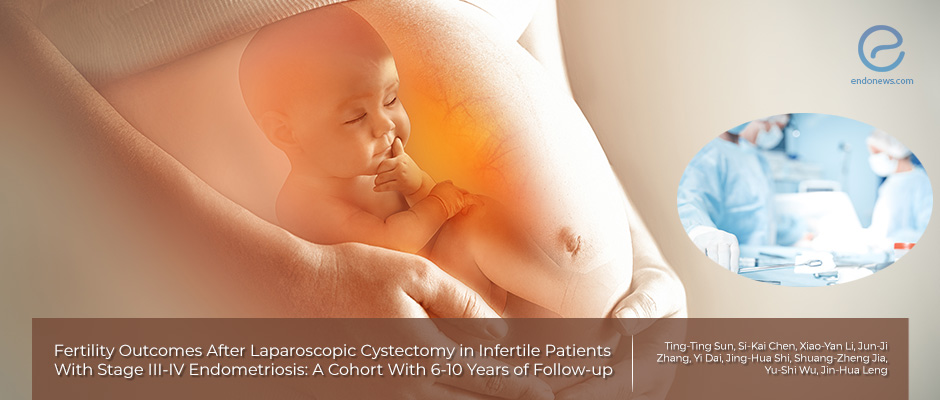Long-term Pregnancy Results after Surgical Removal of Endometrioma
Apr 7, 2020
Infertile patients with endometrioma and stage III-IV endometriosis have a lower rate of recurrence and a higher rate of pregnancy after surgery.
Key Points
Highlights:
- Infertile patients with endometrioma and stage III-IV endometriosis may have lower pregnancy rates after laparoscopic cystectomy only if they are older and have adenomyosis.
What’s done here?
- The authors examined the pregnancy outcomes and the related factors in patients with endometrioma and stage III-IV endometriosis during a long-term follow-up postoperatively.
- Of 347 patients with ovarian endometriosis, 59 infertile patients with stage III-IV endometriosis who had a minimum of 5 years of postoperative follow-up after undergoing laparoscopic excision of ovarian endometriomas included in the study.
Key Points:
- The mean age was 32years, the mean size of endometriomas was 7cm.
- In the 6 year follow-up period, only 23.7% (14/59) of recurrence (the presence of dysmenorrhea, endometrioma, or both) was observed in all patients.
- The ratio of patients who became successfully pregnant by the 5th year after laparoscopic cystectomy was high, %64.4.
- Among the pregnant patients, 21.1% (8/38) needed the help of in vitro fertilization and embryo transfer, while the rest (78.9%, 30/38) were spontaneous pregnancies.
- In total %52.6 of pregnancies within the first year after surgery, only 10% (2/20) were through in vitro fertilization and embryo transfer, and 90% (18/20) were natural.
- Of the 21 patients with failed pregnancies, 10 of them had decreased ovarian function, while 11 had other reasons such as the personal choice to fail in vitro fertilization.
- In multivariate analysis, the mean age of the patient, chronic pelvic pain, and adenomyosis were found to be independent risk factors of pregnancy outcomes between the two groups.
- The initial symptoms of dysmenorrhea and the diagnosis of deep infiltrating endometriosis were not found to be related to pregnancy outcomes.
Limitations:
- This study is a retrospective study and the number of cases is limited.
Lay Summary
Sun et al., from China, investigated the pregnancy outcomes and the related factors in patients with endometrioma and stage III-IV endometriosis along with a long-term follow-up postoperatively. Their study has recently been published in the journal named "Advances in Therapy".
Among 347 patients with ovarian endometriosis, 59 infertile patients with stage III-IV endometriosis who had a minimum of 5 years of postoperative follow-up after undergoing laparoscopic excision of ovarian endometriomas were included in the study.
The mean age was 32 years, the mean size of endometriomas was about 7cm. In the minimum 6 year follow-up period, 23.7% (14/59) of recurrence (the presence of dysmenorrhea, endometrioma, or both) was observed in all patients. The ratio of patients who became successfully pregnant by the 5th year after laparoscopic cystectomy was %64.4. Among the pregnant patients, 21.1% (8/38) occurred with the help of in vitro fertilization and embryo transfer, while the rest (78.9%, 30/38) were spontaneous pregnancies. In total %52.6 of the pregnant patients had become successfully pregnant within the first year after surgery, of which 10% (2/20) were through in vitro fertilization and embryo transfer and 90% (18/20) were natural pregnancies. Of the remaining 21 patients with failed pregnancies, 10 of them had decreased ovarian function, while 11 of them had other reasons such as personal choice and failed in vitro fertilization.
In univariate analysis, the higher mean age and concurrent diagnosis of adenomyosis were seen to be related to poor postoperative pregnancy outcomes. In multivariate analysis, however, the mean age, chronic pelvic pain, and adenomyosis were independent risk factors of pregnancy outcomes between the two groups. The initial symptoms of dysmenorrhea and the diagnosis of deep infiltrating endometriosis were not related to pregnancy outcomes.
The authors concluded that infertile patients with endometrioma and stage III-IV endometriosis might have lower pregnancy rates after laparoscopic cystectomy when they are older and present with chronic pelvic pain and adenomyosis.
Research Source: https://pubmed.ncbi.nlm.nih.gov/32200536
Laparoscopic cystectomy ovarian endometriosis pregnancy rate women’s health

